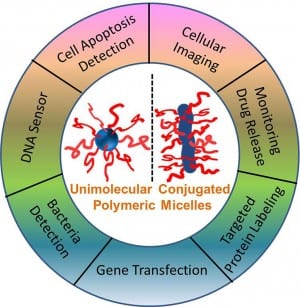 Fluorescent materials have drawn much attention as probes for imaging, diagnosis, and therapy in biological science. Compared to other fluorescent materials, conjugated polymers possess bright fluorescent properties, high photostability, low cytotoxicity and variable emission wavelength. However, emission quenching of conjugated polymers cannot be avoided in aqueous solution because of the strong interaction of the hydrophobic polymer backbones, which limits their wide application in biological area.
Fluorescent materials have drawn much attention as probes for imaging, diagnosis, and therapy in biological science. Compared to other fluorescent materials, conjugated polymers possess bright fluorescent properties, high photostability, low cytotoxicity and variable emission wavelength. However, emission quenching of conjugated polymers cannot be avoided in aqueous solution because of the strong interaction of the hydrophobic polymer backbones, which limits their wide application in biological area.
Xinyuan Zhu – at Shanghai Jiao Tong University – and Feng Qiu – at the Shanghai Institute of Technology – have recently highlighted the unique advantages offered by core-shell unimolecular conjugated polymeric micelles (UCPMs) for biomedical applications.
These micelles consist of a hydrophobic conjugated polymer core and a flexible hydrophilic polymer shell. Differently from traditional conjugated polymers, emission enhancement of UCPMs can be achieved in aqueous medium. The hydrophilic polymer shell of the UCPMs restrict intermolecular aggregation of the conjugated polymer cores. This represents a dramatic advance over previous systems for various biomedical fields.
In their article, the authors introduce typical architectures and synthetic methods of UCPMs. Generally, UCPMs have two main polymeric topological structures: wormlike unimolecular conjugated polymeric micelles and spherical unimolecular conjugated polymeric micelles. In both cases, the synthesis of UCPMs can be classified into three categories: grafting-onto, grafting-from, and grafting-through strategies.
The two researchers discuss the optical properties of the UCPMs and of their self-assembled aggregates. Benefiting from their unique core-shell structure, UCPMs can form stable unimolecular micelles in aqueous solution. Owing to the successful restriction of intermolecular stacking of conjugated polymer cores, these free-standing polymeric micelles show satisfactory fluorescent performance. At very high concentration, UCPMs can self-assemble into hierarchical aggregates by intermolecular interaction of flexible polymer shell. However, π-π stacking of the conjugated polymer cores is avoided during aggregation, resulting in emission enhancement of UCPMs.
Xinyuan Zhu and Feng Qiu point to the advantages offered by UCPMs for biomedical applications. While the conjugated polymer core possesses high fluorescence brightness, the flexible polymeric shell is usually biocompatible, biodegradable, stimuli-responsive and modifiable. Applications of UCPMs in cellular imaging, drug release monitoring, cell apoptosis detection, targeted protein staining, bacterial detection, gene transfection, and DNA sensors are exploited.
The two researchers state that novel synthetic strategies will lead in the future to embedding multifunctional and biocompatible groups onto UCPMs, thus making these unique polymeric systems attractive to scientists working in clinical diagnosis and treatment.
Xinyuan Zhu’s and Feng Qiu’s article is a contribution to the special issue Young Talents in Polymer Science published in Macromolecular Chemistry and Physics.

















